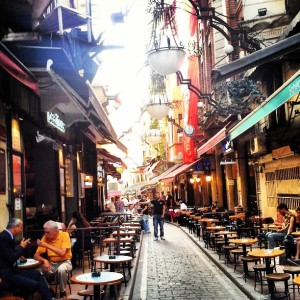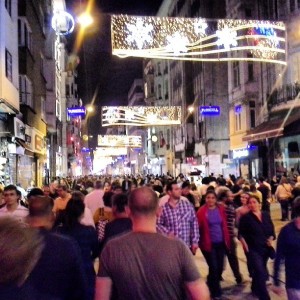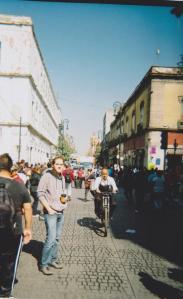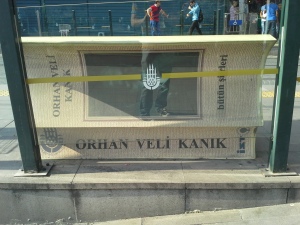Being called the Turkish Summer, both Right to the City theorists and activists have begun to argue that what has occurred in Istanbul and across many parts of Turkey is a classic example of how individuals within organized groups have the power to reclaim and redefine the processes of how cities are developed and governed.
At the center of this protest movement is a new urban development being proposed at Taksim which would essentially demolish one of the largest open public green spaces located in central Istanbul through the reconstruction of an historic army barracks which would include a new shopping mall located inside. Massive demonstrations have erupted against both the project and the resulting heavy handed response by the state. (For those of you living in Richmond, Virginia, this contention against the development could be compared to the ‘Ballpark in the Bottom‘ project located in Shockoe Bottom).
This event represents the importance of one of the most fundamental pillars of urban planning and development, Civic/Public Participation. People of Istanbul are reclaiming their ‘right to the city’ and how it will be developed/governed. Under the guidance of some progressive Turkish urban planners along with activists and scholars, protesters since the beginning of the project are expressing their anger towards how the government has approached its planning practices which has historically neglected public participation. Turkey’s lack of public participation through traditional government level urban planning does not simply create weak and unpopular planning projects but has fermented into an all out insurrection of the masses of the people against the Turkish government and planning departments. Although police violence has been what has escalated some of the protests, poor urban planning policy from governmental officials is at the protest’s heart.
The struggle to reclaim space within Istanbul’s Gezi Parkı/Taksim Square can be defined as ‘a cry and a demand’ for a renewed sense of urban space and life. This method of reclaiming a renewed space in the city comes out of the work from French Philosopher Henri Lefebvre who in 1968 coined the term the “Right to the City” as a way of explaining these types of protest movements.
The term the ‘Right to the City’ (RttC) was first developed by Lefebvre during Parisian uprisings in 1968 (Kuymulu 2013) where he argued that civic protests are groups of individuals acting to demand their right to certain aspects of the city through ‘a cry or demand’. Harvey (2003) takes this argument a step further saying that not only do people have a right to access various parts of the city, but they also possess ‘a right to change it’ (Harvey, 2003; 939).
Information Communication Technologies (ICT/ICTs; a.k.a. social media) are often discussed in understanding the impact on social organizing and changing dynamics of social movements and community organizing. The rise of social media and networking ICTs across the ‘urban digital skin’ within our cities are specifically cited as tools to help develop the capacity for social movements to grow and affect change (Garrett 2006, Rabari 2013). The case of Istanbul’s protest is an excellent example of this ICT enabled social movement.
The Right to the City theorists argues that mobilizations arise in an effort against new forms of ‘neoliberal urbanization’ (Türkmen 2011, Uitermark et al. 2012, Ergn 2006). Türkmen argues that these typically take the form of the people protesting neoliberalism and argues that Istanbul in particular is a place that illustrates this struggle against neoliberal development. Ergin documents the local inhabitant’s struggle against urban renewal projects in Güzeltepe, Istanbul that had developed into a form of ‘gecekondu resistance’ to protect the gecekondu housing structures. This illustrates that local inhabitants begin to employ their struggle of demanding improvements and a change in urban governance and the development within their city.
People are demanding or crying for ‘the right to the city’ and a ‘renewed right to urban life’ through creating spaces of ‘experimental urban utopias’ (Lefebvre 1996).
These spaces become sacred spaces where individuals and groups are able to create their own versions of what they feel is the correct form of and experience with the city in the effort of contesting urban space. This elated feeling can be illustrated from people’s descriptions directly from these spaces. Catterall (2013) discusses the recent Turkish Experience of the Gezi Park protests as being a similar utopia space. He quotes his colleague describing the protest scene saying “there is a sense of wonder when one beholds an event of this kind. New insight is developed through the energies (of people) being so close together. There is a transformation thinking and a change of consciousness” (Catterall 2013, p. 420).
Where did the protesters come from?
For over several months, Turkish civil society has been in an uproar over the proposed construction project on Istanbul’s Gezi Park near Taksim Square. This development in particular can be an example the neoliberal development projects discussed earlier. But this mobilization did not just suddenly arise. I argue that there has been years of civil organizations and engagement occurring in Istanbul for several years and developed into the massive uprising we have seen today.
Academics and RttC practitioners have recognized for some time that Istanbul has been developing the required revolutionary momentum for several years (Ergn 2006, Türkmen 2011). Hoyng (2012) documents the participatory framework that was developed during the Istanbul 2010: European Capital of Culture event. During the time leading up to ‘Istanbul 2010’, a unique ‘place making ‘participatory technique/framework was developed that was focused on engaging people at the neighborhood level to organize together to showcase Istanbul’s unique culture.
Istanbul has a unique neighborhood level culture, known in Turkish as mahalle kültürü. This allowed for an easier proliferation of a new ‘networked governance’. The hope was that this participatory framework would begin to establish a compounding network of networks that would build off of one another. This would develop into the aforementioned ‘network governance’ though the ‘expanding network of self-organizing’. Istanbul 2010 organizers believed that this type of framework, enhanced by social networking technologies, would become ‘a model for the world’ and would showcase the true cultural icons within Istanbul. All of what would be showcased would be developed from the people.
Hoyng even describes the revolutionary potential for this type of participatory framework that alludes to a pending culture of protest and a people’s revolution. Hoyng states that:
“While Networking in urban governance generates particular modalities of participation in and belonging to the creative city, it also enables modalities of staging protest and struggle over urban transformation and the project of the creative city. As I will suggest, possibilities for resistance reside in those forms of engagement and productivity that elaborate transformations and differentiation beyond control.”
This is a very powerful statement and analysis of the revolutionary potential of this form of networked governance. Noting that this publication came out before the massive Gezi Parkı/Taksim Square ‘Turkish Summer’ protests is important to understand the revolutionary potential this form of participatory framework holds.
The Istanbul 2010 participatory model established a framework that was able to bypass traditional forms of identity politics (Hoyng 2012). Being an inhabitant of an area or political body defined participation. Furthermore, one’s level of participation within this participatory paradigm defined their authority or overall ‘level of participation’. Hoyng developed the term ‘Popping up and Fading Out’ to illustrate this practice. Hoyng points out the inherent participatory dimensions of Information Communication Technology (ICT) enabled social networks illustrating that “participatory subjects ‘pop up’ (when using the ICTs) and then ‘fade out’ (when not using the ICTs), after which they have no visible presence.”
The Istanbul 2010 participatory model established a framework that was able to bypass traditional forms of identity politics (Hoyng 2012). Being an inhabitant of an area or political body defined participation. Furthermore, one’s level of participation within this participatory paradigm defined their authority. Hoyng developed the term ‘Popping up and Fading Out’ to illustrate this practice.
Hoyng points out the inherent participatory dimensions of ICT enabled social networks illustrating that “participatory subjects ‘pop up’ (when using the ICTs) and then ‘fade out’ (when not using the ICTs), after which they have no visible presence.” (2012; p. 13).
Iveson (2013) illustrates that we are re-framing where decisions are being made towards a “radical form of enfranchisement” (2013, p. 945). This change in where and who can participate in democracy is a shift away from traditional identity politics that dominates decision making processes in society. ICT enabled civic engagement has redefined key aspects of democracy and who can participate.
But, is the Turkish political establishment (including current urban planning practitioners) a part of this new political paradigm?
During the first weeks of the protests, Turkey’s Prime Minister Tayyip Erdoğan referred to Twitter as a ‘Pest’ and said, “The thing that is called social media is the biggest trouble for society right now.” This is a clear illustration showing how Turkey’s political leadership is completely unaware and unwilling to participate in this new age of democracy and civic engagement. It is imperative that the current momentum of civic participation be captured and implanted into the mechanisms of urban planning within the Turkish government.
Social media has been at the core medium of communication during the protests. Facebook groups, Twitter feeds, and images of police violence have galvanized a message of solidarity against the government both within Turkey and across the world. But the revolutionary spirit of the Turkish population isn’t an isolated case but rather is the nature of our historical moment across the world. This internationalization of local struggle is known as ‘Glocalism’. The term Glocalism refers to the capacity for social movements to be able to frame global struggles into the local context and vice versa (Wallin & Horelli 2012). Framing the struggle through a Glocal lens allows for local social movements and struggles to be framed and connected with similar struggles across the globe. Furthermore, community networks are able to build stronger networks when connected to global context (De Cindio & Schuler 2012).
A new age of governance is emerging in recent years which embraces new democratic elements that are an innate product of these new media outlets. These outlets help to facilitate and challenges against existing power structures through the massive exchange and collaboration of people and ideas.
Urban planners have a strong desire for civic participation but are many times unsuccessful in capturing participation from the public using traditional methods of engagement. Today, Turkey has a truly amazing opportunity to seize the unprecedented level of civic engagement to improve it’s urban planning practices and develop a truly democratic politic. As a result from the protests against the Gezi Park project, people from all walks of Turkish society are becoming active participants in the urban planning process.
Without any political leadership capturing this social momentum, Turkey will lose a great opportunity of institutionalizing strong and progressive planning practices.




